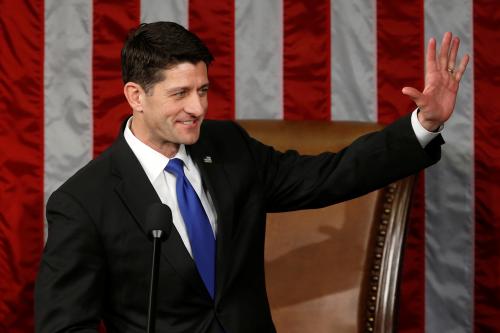This article originally appeared in Real Clear Markets on March 29, 2017.
The Republicans’ failure to repeal Obamacare puts pressure on them to win the next big policy battle, on taxes. But the inherent political and economic trade-offs are likely to deter anything resembling a sweeping tax reform effort. The Republicans will likely have to define a “win” as a revenue-losing tax cut.
Distance is a tax reform’s best friend. Many proposals look good at an abstract level, only to be done in by the details. As with health care, agreement on the “repeal” part is not sufficient to generate agreement on the “replace” part.
As a result, there’s been no significant tax reform since 1986 and the effort leading up to that event was heroic. It took several years of studies and proposals, strong White House leadership from a popular president in a second term, and bi-partisan vision and courage from members of Congress. Even that was not enough, though, as the proposal was dead on the vine at various points, and it took a get-together in a bar to restart the process one last time. When legislation was finally up for a vote, the distributional estimates were fudged in a way that made it look like everyone was better off (the increased burden of the corporate tax changes were left out).
Tax reform is rare because it requires resolution of difficult trade-offs. Here are three relevant examples:
Tax cuts for the middle class
Both Treasury Secretary Mnuchin and President Trump have said they want middle-class tax cuts. But cutting taxes for middle-income households almost necessitates cuts for high-income households, too. Unless the tax cut is phased out as income rises, which raises marginal tax rates and creates complexity, the rich gain from any cut given to lower income groups. Tax cuts for the middle-class and the rich mean that overall tax revenues will fall. Unless spending is reduced, too, deficits will rise.
The corporate tax rate
At 35 percent, our corporate tax rate is the highest in the world and widely believed to be too high. So, we should cut it, right? One proposal—cutting the rate to 28 percent and financing that by eliminating corporate tax deductions—would have perverse effects: It would likely raise the cost of new investment and reduce economic growth, exactly the opposite of the reason for tackling business tax reform in the first place. If we slashed the rate further, to 20 percent or 15 percent, as others have proposed, we would open up wide gaps between taxes on corporate income and taxes on other businesses. If we cut the rate on other businesses, too we create enormous tax incentives for people to re-characterize their wage income as business income. If we cut the tax rate on corporate, non-corporate business, and wage income, we create enormous deficits.
Taxation of foreign income
U.S. taxes on the foreign income of U.S. corporations leave no one happy. The system raises little revenue, and it encourages firms to shift profits, productive activity, and headquarters out of the country. What to do? If we aim to tax all worldwide income of U.S. corporations, it will make them less competitive globally and encourage them to leave the country. But if we instead move to a territorial system, where we don’t tax foreign income at all, we would greatly increase incentives for shifting profits to other countries.
There are no easy answers to these trade-offs, even under the best of political circumstances. And with the Republicans in disarray and the Democrats not eager to bail them out, reform will be even more difficult to bring about.
The Republicans’ failure to repeal Obamacare puts pressure on them to win the next big policy battle, on taxes. But the inherent political and economic trade-offs are likely to deter anything resembling a sweeping tax reform effort.
The “destination-based cash-flow” tax (DBCFT) advocated by House Speaker, Paul Ryan, and Ways and Means Chair, Kevin Brady, as a replacement for the corporate income tax provides a good example of why reform will be hard going forward. The “destination-based” part would come about through border adjustments—taxes on imports and exemptions for exports—that have many business groups and lawmakers up in arms. The “cash flow” part requires repealing the business deduction for interest payments, which Trump—the self-described “king of debt” – does not favor. Politically, the proposal divides the business community, with importers, retailers, and the apparel and oil industry among the strongest opponents.
So the DBCFT is likely to be a non-starter. But there’s no Plan B for tax reform on the horizon, and the health care reform experience shows how hard it is to gin up a comprehensive policy on the fly.
So talk will naturally turn to tax cuts. Republican leaders can hope that tax cuts will be revenue-neutral once the growth-enhancing effects are taken into account. But those rosy scenarios won’t come out of CBO or JCT, given their previous estimates, which quite reasonably show small effects of tax cuts on growth.
Still, the pressure will be on the Republicans to show they can carry out their policy promises. Their ultimate push for tax cuts is consistent with their policy stance since Reagan was president. As the late columnist Robert Novak said, “God put the Republican Party on earth to cut taxes.”
Just as the proposals in the failed health care reform effort would have cut taxes substantially for the rich, the proposals in the House GOP “Blueprint” (even if we leave out the DBCFT), would end up cutting taxes substantially for high-income households. It would be a bad idea to, at a time when the economy is strong, cut taxes for people who don’t need the benefit, financed by deficits that will be borne by future generations who don’t have a seat at the table. But it is hard to see how revenue-neutral reform could garner the political support it would need under current circumstances.






Commentary
Op-edThe Republicans will struggle to “win” on tax reform
March 29, 2017